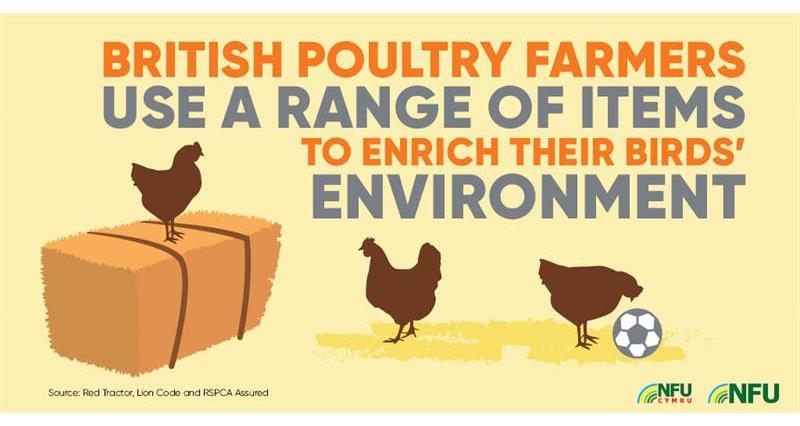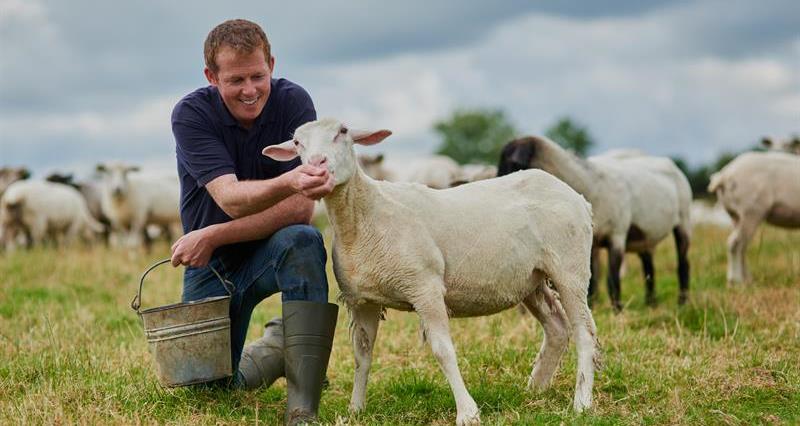The UK has one of the most robust and comprehensive legal frameworks protecting animals on farms, extremely mature and well-developed industry bodies that recognise the importance of animal welfare, and a significant number of credible quality assurance and welfare schemes and/or initiatives.
The NFU commissioned a global review of farm animal welfare. Read a summary of the report here.
What is animal welfare?
There is no universally agreed definition of what constitutes animal welfare, but the World Organisation for Animal Health’s (OIE) is the most accepted. It has Five Freedoms of animal welfare:
- Freedom from thirst, hunger and malnutrition
- Freedom from discomfort and exposure
- Freedom from pain, injury and disease
- Freedom from fear and distress
- Freedom to express normal behaviour.
When caring for animals, British farmers provide suitable housing, bedding and correct nutrition, as well as using medicines responsibly.
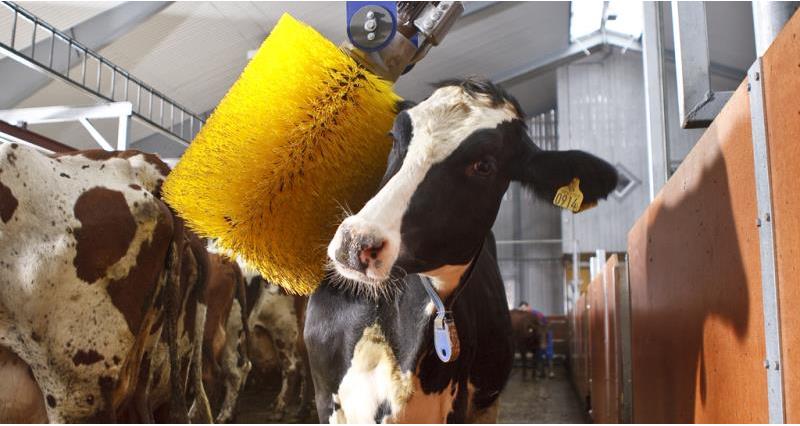
Pictured above: Many dairies have robotic cow brushes. The cows love the way they feel and they help to keep the cows clean.
We've put together a list of questions and answers to help you understand more about British farming and animal health and welfare.
Antibiotics play an important role in preventing pain and suffering in our farm livestock as well as ensuring food safety.
To make sure their animals are in top health, British farmers follow best practice guidelines determined by experts and based on science. British farmers are committed to using medicines and treatments as little as possible but as much as is necessary so animals stay healthy, and in turn, our food is safe to eat.
The UK farming industry has already achieved reductions of 53% in sales of antibiotics over the past five years and is one of the lowest users of antibiotics in Europe.
A Government-compiled report released in 2015 compared 2013 data for human prescriptions and animal sales of antibiotics. It found that around 56% of antibiotics were used in humans and 44% in animals. It is judged that around 7% of the total is use in companion animals (pets). However, there are far more farm animals than humans in the UK – over a billion compared with 65 million humans. So comparing instead by mass, UK humans use around 2.4 times more antibiotics per kg of their weight than farm animals.
The risk of human illness as a result of antibiotic resistance in farm animals is actually quite low.
Medicines are highly regulated and the rules for how they are used in farming are strict – they have to go through rigorous testing to ensure they are safe, before they become available and can be prescribed by vets.
RUMA (Responsible Use of Medicines in Agriculture) is an organisation that produces scientifically-based guidelines for farmers, vets and advisers to help promote the highest standards of food safety, animal health and animal welfare in the British livestock industry.
It is a unique, independent non-profit group involving organisations that represent all stages of the food chain, from farm to fork.
RUMA aims to produce a co-ordinated and integrated approach to best practice in animal medicine use. It has an established communications network with government departments and many non-governmental organisations.
All farmers that farm to Red Tractor standards and other accredited schemes must maintain a written health plan and medicine records so they can monitor the health of their animals and help prevent them from becoming unwell. This also helps the farmer know when to call the vet for expert advice.
Transport of live animals
Many British livestock (beef and sheep) farmers produce stock for export. The trade in live animals is vitally important to the productivity of British farming, however the trade in live animals has reduced in recent years, with a greater focus on the export of carcases and cuts of meat.
British farmers have a legal responsibility to ensure their animals are transported in a way that won’t cause injury or unnecessary suffering to them.
The current legislation requires anyone transporting live animals to ensure that any journey is adequately planned and the time in transit is kept to the minimum possible. Animals must be fit to travel, and provided with adequate water, feed and rest and provided with sufficient floor space and height.
EU Law (EU Council Regulation 1/2005) sets the standards for animal welfare during transport. It is implemented nationally through The Welfare of Animals (Transport) (England) order 2006 and equivalent legislation in Scotland, Wales and Northern Ireland.
Farmers and those who transport livestock, must hold a Certificate of Competence which allows transportation of animals on domestic journeys under 8 hours within the UK.
Dairy calves

For several reasons, be it culture, history or nutritional benefits, 98% of the public consume dairy products. It is therefore essential to have a national dairy herd to serve this demand for home-grown dairy produce. Farmers and vets work together to find the best way to do this from a welfare perspective.
Experts recommend that calves are separated from their mothers as soon as possible, as this minimizes stress to mother and calf. The mother is returned to the main herd to eat and recoup energy after calving. Many dairy farmers raise their calves in a special area of the farm, where they are given additional dedicated care to ensure they reach peak condition in a protected environment. During the first 24 hours, newborn calves are fed colostrum, as this provides essential antibodies to protect them against illness or disease.
Calves continue to receive milk for several weeks after birth. During this time they are gradually introduced to other foods, with nutritionists and vets helping the farmer to develop a diet plan suited to the calves' age and size. After weaning, female dairy calves are generally reared to join the milking herd.
Another key reason for keeping calves separate from the herd is to reduce the risk of illness whilst they are building their immune systems. The risk of pneumonia is greatly increased if calves are kept with a mix of animals of all ages. It also prevents the calves from being trampled or bullied by other adult cows.
Red Tractor Farm Assurance requires farmers to follow recognised and independently inspected standards of calf health and welfare.
Standard dairy industry practice is to separate calves within 24 hours of birth. This is done to reduce the risk of disease transmission to the calf, to ensure adequate colostrum (first form of milk production) and feed intake, and to simplify disease detection. Separation of the calf from the dam also occurs to facilitate milking and management of the cow.
Sheep shearing

Shearing must take place for the health and hygiene of the animals.
Most sheep are unable to shed their coat, risking overheating and potential death in hot climates. Therefore shearing is generally carried out in the spring so that sheep don't overheat in the summer.
Shearing also prevents the fleece from dragging along the ground in the dirt, therefore preventing infection.
No, the process is pain free; it is similar to a man having a haircut at the barbers. We musn't forget that sheep are live animals and prone to wriggling, so there is the odd occasion where the farmer accidentally cuts the sheep, but this is always cleaned up quickly to make sure the sheep is comfortable and free from infections.
Pigs and piglets
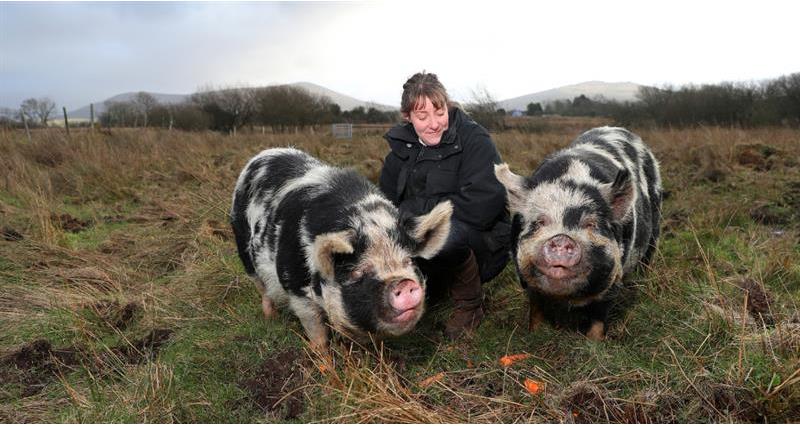
Tail biting is an undesirable problem where pigs bite and chew the tails of pen mates. There are many factors for this including health problems and dominating pigs. Tail biting can occur in all types of production from indoor to free range.
Tail docking has been scientifically proven to reduce the likelihood and severity of tail biting permitted following veterinary advice under EU Council Directive 2008/120/EC. Tail docking may only be done where there is evidence of tail injuries and where other measures to prevent tail-biting have been tried, taking into account environmental factors and stocking density.
Only a veterinarian or somebody that has been trained and deemed competent in the procedure is permitted to carry out tail-docking.
You can find out more information on tail docking on the National Pig Association's website.
Put simply, pregnant pigs are kept in crates for safety reasons. Farrowing (giving birth) crates are permitted for female pigs (sows and gilts) from the week before expected farrowing, during farrowing and until the piglets are weaned from her.
The primary purpose of the farrowing crate is to prevent the sow from rolling on and crushing her piglets (due to the sow being about 150 times the size of the piglets).
The crate also enables stockpersons (a person who works with pigs) to work easily and safely around the sow and her piglets, during a time when sows can be particularly aggressive.
Piglets are usually weaned between 21 and 28 days of age, meaning most sows spend a maximum of five weeks in a farrowing crate in any one period. After weaning, pigs are moved to group housing until they are due to farrow.
More information can be found on the National Pig Association website here.
The Animal and Plant Health Agency is warning farmers and smallholders not to feed catering or kitchen waste to livestock such as pigs and poultry, even if they are being kept as pets.
It remains illegal to feed catering waste, kitchen scraps, meat or meat products to farmed animals. This is to prevent the introduction and spread of potentially devastating notifiable animal diseases, such as African and Classical Swine Fever, and Foot and Mouth disease. These diseases cause significant animal health and welfare problems and damage to the economy.
Chickens
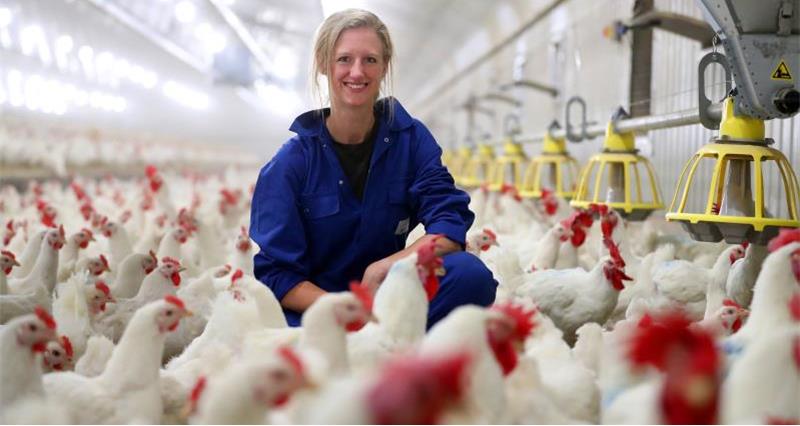
In January 2012 battery cages were banned in the UK. There are now only three higher welfare methods of egg production in the UK: free range, barn and enriched colony cage.
The enriched colony was developed to meet an EU directive that came into law in 1999 and replaced all battery cages from January 2012. Birds are still housed indoors and are still in a cage but it is a very different environment to the previous system. ‘Enriched’ because the cage includes features such as a scratch area, perch and nest box; ‘colony’ because the number of birds kept in these significantly larger cages are typically up to 80 birds.
The health and welfare of their birds is a farmers’ number one priority. They are raised in environments where they have access to food, water, warmth and plenty of space to roam and scratch as they please. Every farmer has their own creative ways to entertain the hens and keep them occupied. This might be to hang pieces of string around with CDs attached for them to peck, give the birds a football to play with, add extra perches or a dust bath to scratch in or provide vegetables to peck at.
A bird’s welfare is any farmer’s ultimate priority, and there are several rules and regulations in place to ensure the bird’s welfare. UK, Red Tractor and RSPCA standards make sure that the stocking density is controlled and managed. In simple terms this means that there are not too many birds in a given space.
Over 90% of poultry meat farms are Red Tractor assured. This means that their product meets strict standards of animal welfare, safety, hygiene and traceability. Red Tractor strictly monitors the scheme and any farmers found not to be adhering to standards are immediately removed from the assurance scheme. Red Tractor farms are checked by the assurance scheme every year to make sure they are complying with their strict standards.
Chlorinated chicken, or chlorine-washed chicken, refers to chicken that has been dipped or washed in chlorinated water to remove harmful bacteria. It’s a process which is banned in Britain but used by some US poultry producers.
The UK adopts a ‘farm-to-fork’ approach to food safety and only drinking water is permitted to wash chicken carcasses post-slaughter. Banning the use of chlorine in British poultry meat production ensures that higher standards of hygiene and animal welfare are met throughout each stage of the process, rather than relying on a chemical to kill any harmful pathogens and bacteria post-slaughter.
British farmers are rightly proud of their world leading food standards, and a post-Brexit trade agreement with the US puts this at risk.
